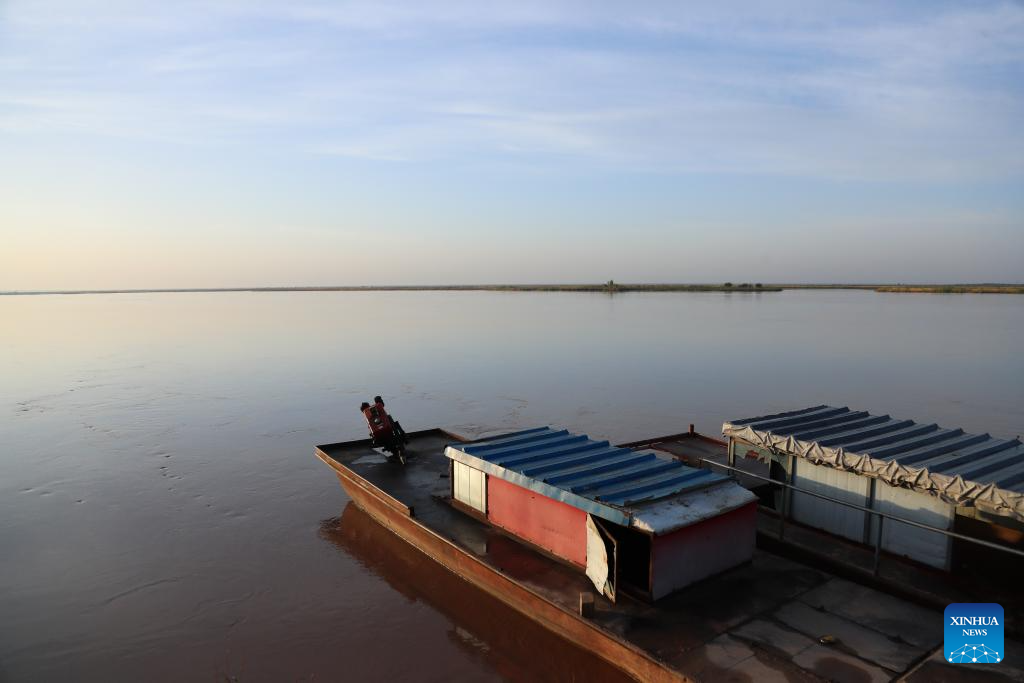
This aerial photo taken on Sept. 15, 2023 shows a view of the Yellow River in Bayannur, north China's Inner Mongolia Autonomous Region.
The Hetao Irrigation Area, located in Bayannur, north China's Inner Mongolia Autonomous Region, has been diverting water from the Yellow River for irrigate since the Qin Dynasty (221 B.C.-206 B.C.). The current irrigation area stands at 11.54 million mu.
The 2,200-year-old irrigation project, included in the World Heritage Irrigation Structures in 2019, uses gravity to transport the Yellow River water into fields. As one of China's most important grain and oil production bases, this area has yielded over 3 billion kg of grain on average annually in recent years.
In recent years, Bayannur has explored the modernization, water-saving transformation and ecological governance of the Hetao Irrigation Area. It has used information technology to improve the fine management of this area and promote the efficient use of water resources in an environmentally friendly way. With these efforts, the Hetao Irrigation Area has seen a continuous sustainable development in recent years. (Xinhua/Wang Kaiyan)
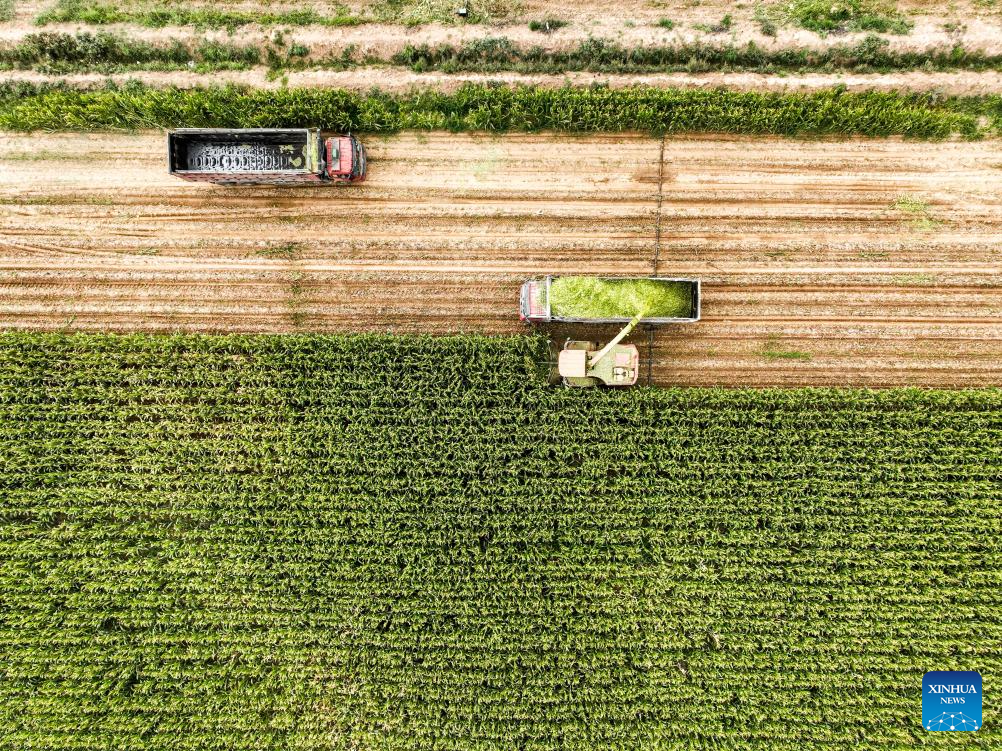
This aerial photo taken on Sept. 14, 2023 shows farmers operating harvesters to reap corn crops in Linhe District of Bayannur, north China's Inner Mongolia Autonomous Region.
The Hetao Irrigation Area, located in Bayannur, north China's Inner Mongolia Autonomous Region, has been diverting water from the Yellow River for irrigate since the Qin Dynasty (221 B.C.-206 B.C.). The current irrigation area stands at 11.54 million mu.
The 2,200-year-old irrigation project, included in the World Heritage Irrigation Structures in 2019, uses gravity to transport the Yellow River water into fields. As one of China's most important grain and oil production bases, this area has yielded over 3 billion kg of grain on average annually in recent years.
In recent years, Bayannur has explored the modernization, water-saving transformation and ecological governance of the Hetao Irrigation Area. It has used information technology to improve the fine management of this area and promote the efficient use of water resources in an environmentally friendly way. With these efforts, the Hetao Irrigation Area has seen a continuous sustainable development in recent years. (Xinhua/Xing Guangli)
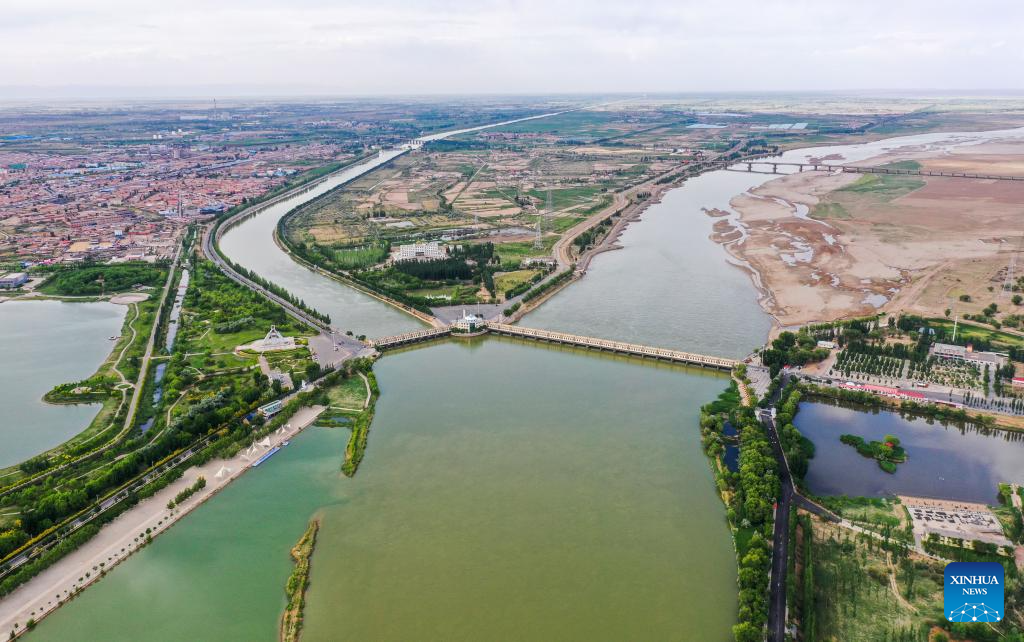
This aerial photo taken on June 6, 2023 shows the Sanshenggong Water Control Project which diverts water from the Yellow River in Bayannur, north China's Inner Mongolia Autonomous Region.
The Hetao Irrigation Area, located in Bayannur, north China's Inner Mongolia Autonomous Region, has been diverting water from the Yellow River for irrigate since the Qin Dynasty (221 B.C.-206 B.C.). The current irrigation area stands at 11.54 million mu.
The 2,200-year-old irrigation project, included in the World Heritage Irrigation Structures in 2019, uses gravity to transport the Yellow River water into fields. As one of China's most important grain and oil production bases, this area has yielded over 3 billion kg of grain on average annually in recent years.
In recent years, Bayannur has explored the modernization, water-saving transformation and ecological governance of the Hetao Irrigation Area. It has used information technology to improve the fine management of this area and promote the efficient use of water resources in an environmentally friendly way. With these efforts, the Hetao Irrigation Area has seen a continuous sustainable development in recent years. (Xinhua/Lian Zhen)
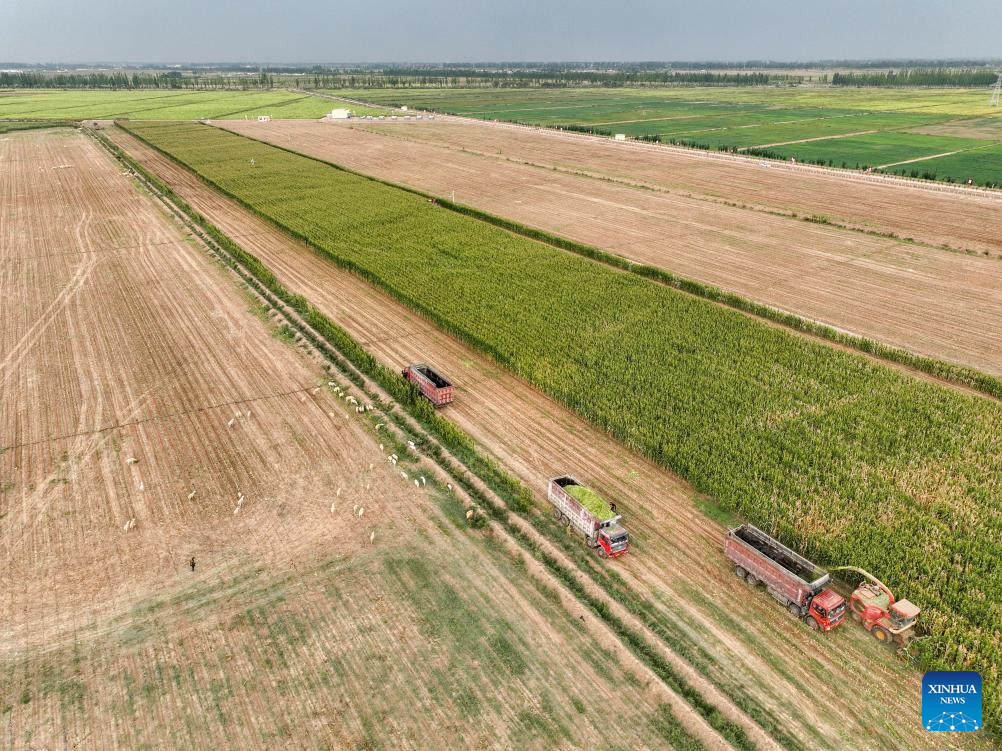
This aerial photo taken on Sept. 14, 2023 shows farmers operating harvesters to reap corn crops in Linhe District of Bayannur, north China's Inner Mongolia Autonomous Region.
The Hetao Irrigation Area, located in Bayannur, north China's Inner Mongolia Autonomous Region, has been diverting water from the Yellow River for irrigate since the Qin Dynasty (221 B.C.-206 B.C.). The current irrigation area stands at 11.54 million mu.
The 2,200-year-old irrigation project, included in the World Heritage Irrigation Structures in 2019, uses gravity to transport the Yellow River water into fields. As one of China's most important grain and oil production bases, this area has yielded over 3 billion kg of grain on average annually in recent years.
In recent years, Bayannur has explored the modernization, water-saving transformation and ecological governance of the Hetao Irrigation Area. It has used information technology to improve the fine management of this area and promote the efficient use of water resources in an environmentally friendly way. With these efforts, the Hetao Irrigation Area has seen a continuous sustainable development in recent years. (Xinhua/Xing Guangli)
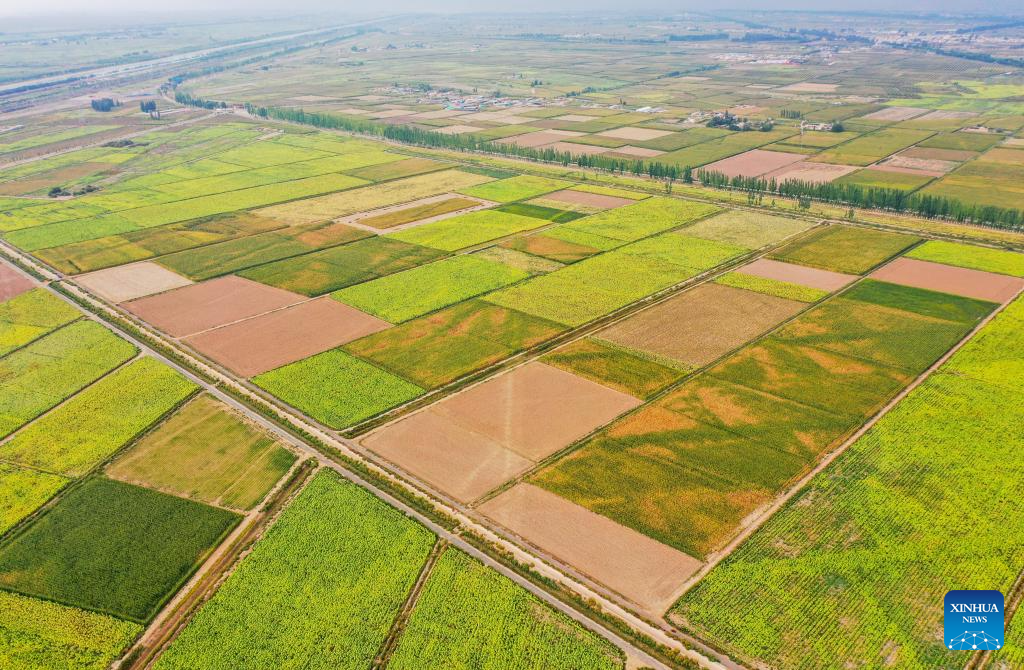
This aerial photo taken on Sept. 14, 2023 shows fields which use a drip irrigation system in Linhe District of Bayannur, north China's Inner Mongolia Autonomous Region.
The Hetao Irrigation Area, located in Bayannur, north China's Inner Mongolia Autonomous Region, has been diverting water from the Yellow River for irrigate since the Qin Dynasty (221 B.C.-206 B.C.). The current irrigation area stands at 11.54 million mu.
The 2,200-year-old irrigation project, included in the World Heritage Irrigation Structures in 2019, uses gravity to transport the Yellow River water into fields. As one of China's most important grain and oil production bases, this area has yielded over 3 billion kg of grain on average annually in recent years.
In recent years, Bayannur has explored the modernization, water-saving transformation and ecological governance of the Hetao Irrigation Area. It has used information technology to improve the fine management of this area and promote the efficient use of water resources in an environmentally friendly way. With these efforts, the Hetao Irrigation Area has seen a continuous sustainable development in recent years. (Xinhua/Lian Zhen)
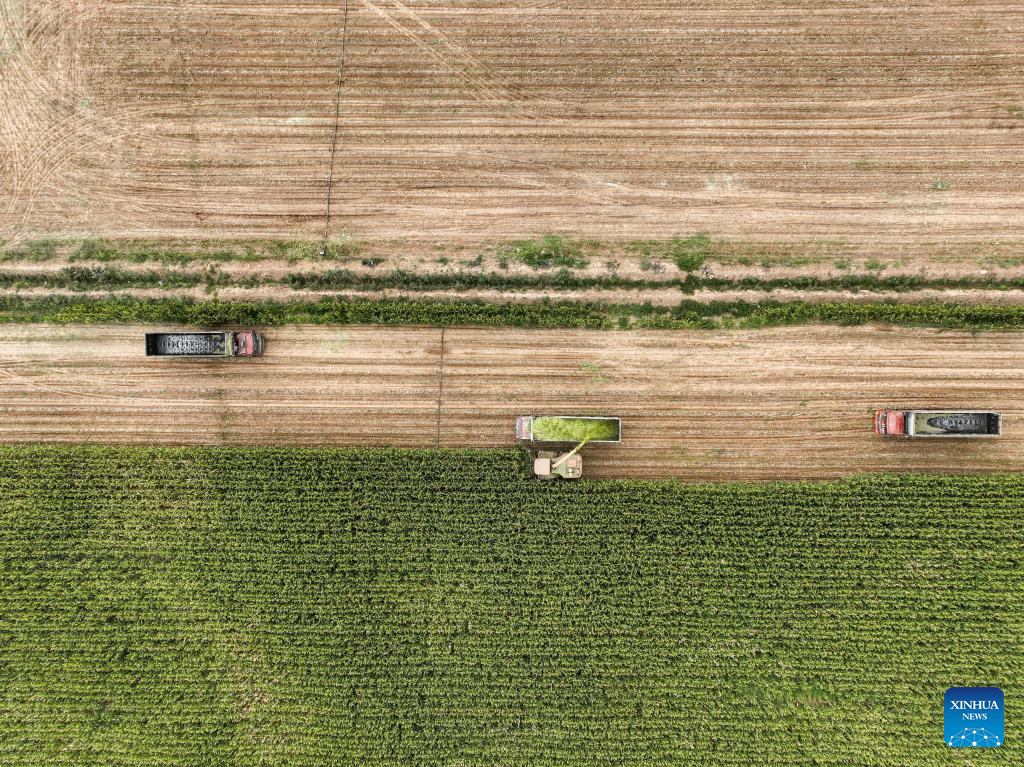
This aerial photo taken on Sept. 14, 2023 shows farmers operating harvesters to reap corn crops in Linhe District of Bayannur, north China's Inner Mongolia Autonomous Region.
The Hetao Irrigation Area, located in Bayannur, north China's Inner Mongolia Autonomous Region, has been diverting water from the Yellow River for irrigate since the Qin Dynasty (221 B.C.-206 B.C.). The current irrigation area stands at 11.54 million mu.
The 2,200-year-old irrigation project, included in the World Heritage Irrigation Structures in 2019, uses gravity to transport the Yellow River water into fields. As one of China's most important grain and oil production bases, this area has yielded over 3 billion kg of grain on average annually in recent years.
In recent years, Bayannur has explored the modernization, water-saving transformation and ecological governance of the Hetao Irrigation Area. It has used information technology to improve the fine management of this area and promote the efficient use of water resources in an environmentally friendly way. With these efforts, the Hetao Irrigation Area has seen a continuous sustainable development in recent years. (Xinhua/Xing Guangli)

This aerial photo taken on Sept. 15, 2023 shows a view of the Yellow River in Shuanghe Town of Linhe District in Bayannur, north China's Inner Mongolia Autonomous Region.
The Hetao Irrigation Area, located in Bayannur, north China's Inner Mongolia Autonomous Region, has been diverting water from the Yellow River for irrigate since the Qin Dynasty (221 B.C.-206 B.C.). The current irrigation area stands at 11.54 million mu.
The 2,200-year-old irrigation project, included in the World Heritage Irrigation Structures in 2019, uses gravity to transport the Yellow River water into fields. As one of China's most important grain and oil production bases, this area has yielded over 3 billion kg of grain on average annually in recent years.
In recent years, Bayannur has explored the modernization, water-saving transformation and ecological governance of the Hetao Irrigation Area. It has used information technology to improve the fine management of this area and promote the efficient use of water resources in an environmentally friendly way. With these efforts, the Hetao Irrigation Area has seen a continuous sustainable development in recent years. (Xinhua/Xing Guangli)
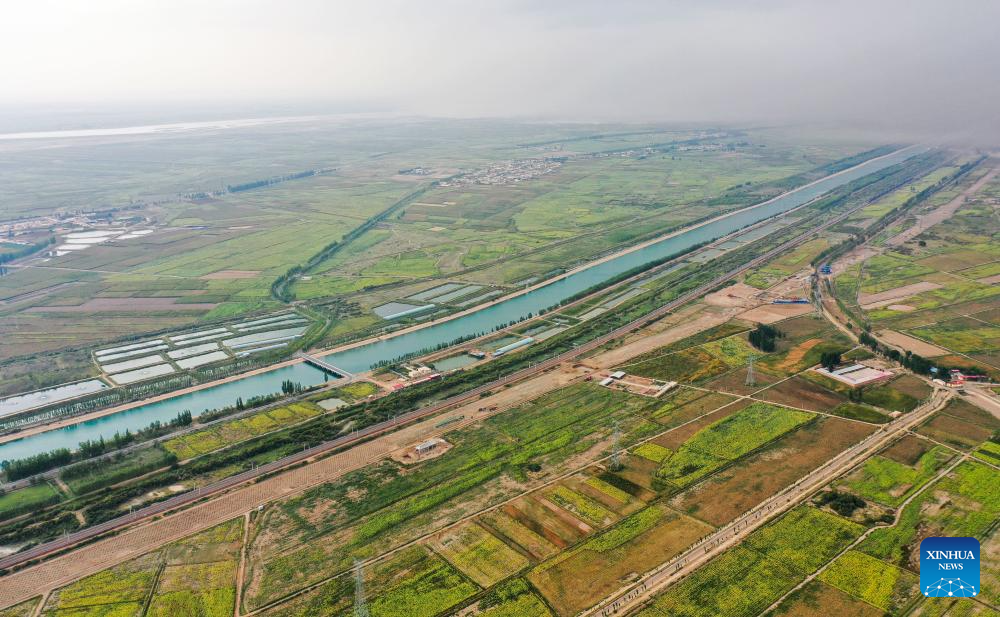
This aerial photo taken on Sept. 14, 2023 shows an irrigation project that draws water from the Yellow River in Linhe District of Bayannur, north China's Inner Mongolia Autonomous Region.
The Hetao Irrigation Area, located in Bayannur, north China's Inner Mongolia Autonomous Region, has been diverting water from the Yellow River for irrigate since the Qin Dynasty (221 B.C.-206 B.C.). The current irrigation area stands at 11.54 million mu.
The 2,200-year-old irrigation project, included in the World Heritage Irrigation Structures in 2019, uses gravity to transport the Yellow River water into fields. As one of China's most important grain and oil production bases, this area has yielded over 3 billion kg of grain on average annually in recent years.
In recent years, Bayannur has explored the modernization, water-saving transformation and ecological governance of the Hetao Irrigation Area. It has used information technology to improve the fine management of this area and promote the efficient use of water resources in an environmentally friendly way. With these efforts, the Hetao Irrigation Area has seen a continuous sustainable development in recent years. (Xinhua/Lian Zhen)
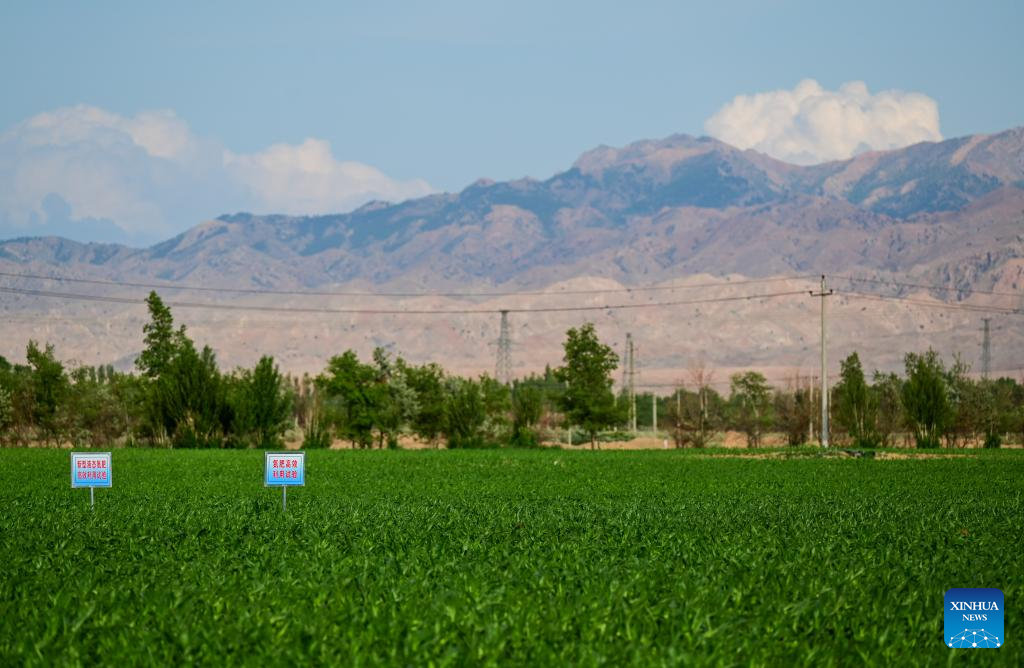
This photo taken on June 5, 2023 shows a modern agricultural demonstration field in Urad Front Banner in Bayannur, north China's Inner Mongolia Autonomous Region.
The Hetao Irrigation Area, located in Bayannur, north China's Inner Mongolia Autonomous Region, has been diverting water from the Yellow River for irrigate since the Qin Dynasty (221 B.C.-206 B.C.). The current irrigation area stands at 11.54 million mu.
The 2,200-year-old irrigation project, included in the World Heritage Irrigation Structures in 2019, uses gravity to transport the Yellow River water into fields. As one of China's most important grain and oil production bases, this area has yielded over 3 billion kg of grain on average annually in recent years.
In recent years, Bayannur has explored the modernization, water-saving transformation and ecological governance of the Hetao Irrigation Area. It has used information technology to improve the fine management of this area and promote the efficient use of water resources in an environmentally friendly way. With these efforts, the Hetao Irrigation Area has seen a continuous sustainable development in recent years. (Xinhua/Lian Zhen)
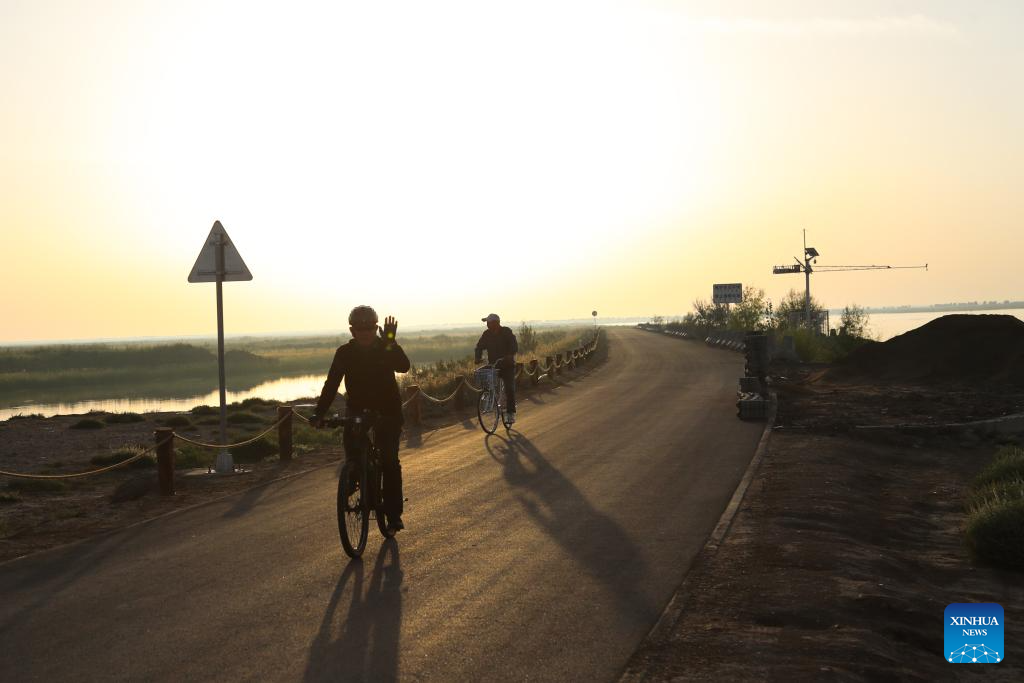
People ride bikes on the bank of the Yellow River in Bayannur, north China's Inner Mongolia Autonomous Region, Sept. 15, 2023.
The Hetao Irrigation Area, located in Bayannur, north China's Inner Mongolia Autonomous Region, has been diverting water from the Yellow River for irrigate since the Qin Dynasty (221 B.C.-206 B.C.). The current irrigation area stands at 11.54 million mu.
The 2,200-year-old irrigation project, included in the World Heritage Irrigation Structures in 2019, uses gravity to transport the Yellow River water into fields. As one of China's most important grain and oil production bases, this area has yielded over 3 billion kg of grain on average annually in recent years.
In recent years, Bayannur has explored the modernization, water-saving transformation and ecological governance of the Hetao Irrigation Area. It has used information technology to improve the fine management of this area and promote the efficient use of water resources in an environmentally friendly way. With these efforts, the Hetao Irrigation Area has seen a continuous sustainable development in recent years. (Xinhua/Wang Kaiyan)
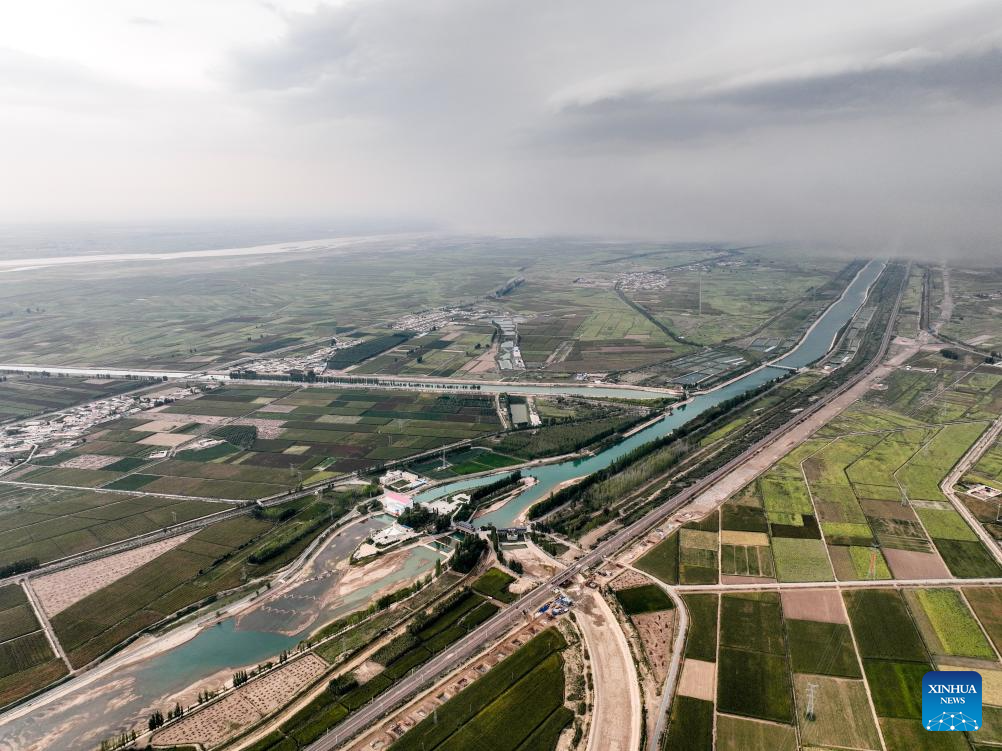
This aerial photo taken on Sept. 14, 2023 shows an irrigation project that draws water from the Yellow River in Linhe District of Bayannur, north China's Inner Mongolia Autonomous Region.
The Hetao Irrigation Area, located in Bayannur, north China's Inner Mongolia Autonomous Region, has been diverting water from the Yellow River for irrigate since the Qin Dynasty (221 B.C.-206 B.C.). The current irrigation area stands at 11.54 million mu.
The 2,200-year-old irrigation project, included in the World Heritage Irrigation Structures in 2019, uses gravity to transport the Yellow River water into fields. As one of China's most important grain and oil production bases, this area has yielded over 3 billion kg of grain on average annually in recent years.
In recent years, Bayannur has explored the modernization, water-saving transformation and ecological governance of the Hetao Irrigation Area. It has used information technology to improve the fine management of this area and promote the efficient use of water resources in an environmentally friendly way. With these efforts, the Hetao Irrigation Area has seen a continuous sustainable development in recent years. (Xinhua/Xing Guangli)
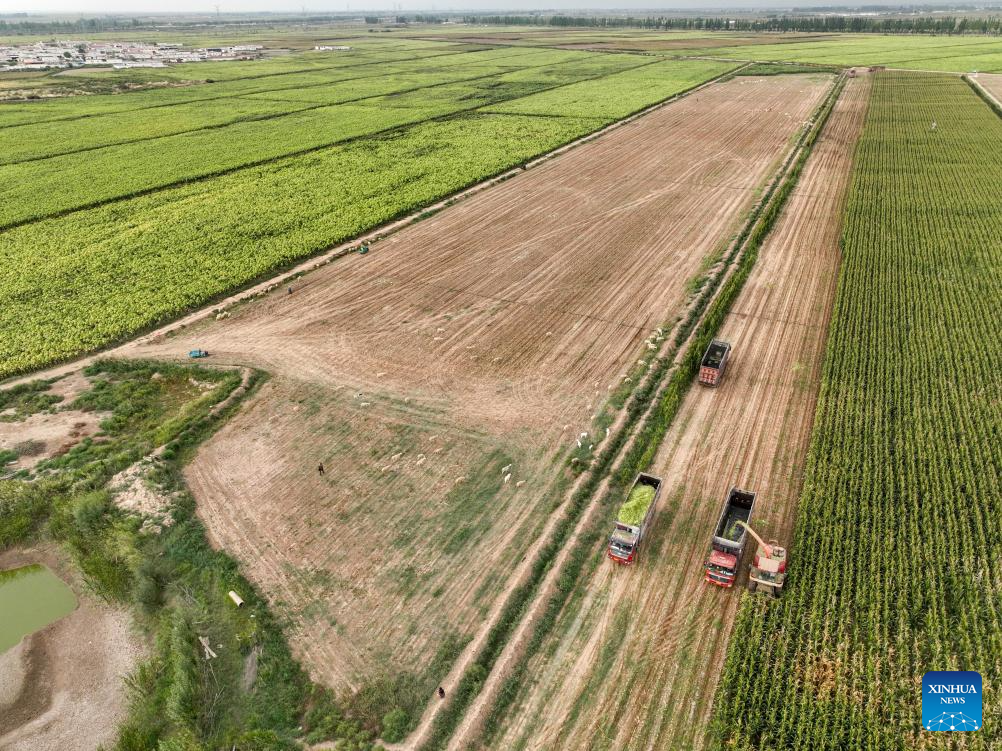
This aerial photo taken on Sept. 14, 2023 shows farmers operating harvesters to reap corn crops in Linhe District of Bayannur, north China's Inner Mongolia Autonomous Region.
The Hetao Irrigation Area, located in Bayannur, north China's Inner Mongolia Autonomous Region, has been diverting water from the Yellow River for irrigate since the Qin Dynasty (221 B.C.-206 B.C.). The current irrigation area stands at 11.54 million mu.
The 2,200-year-old irrigation project, included in the World Heritage Irrigation Structures in 2019, uses gravity to transport the Yellow River water into fields. As one of China's most important grain and oil production bases, this area has yielded over 3 billion kg of grain on average annually in recent years.
In recent years, Bayannur has explored the modernization, water-saving transformation and ecological governance of the Hetao Irrigation Area. It has used information technology to improve the fine management of this area and promote the efficient use of water resources in an environmentally friendly way. With these efforts, the Hetao Irrigation Area has seen a continuous sustainable development in recent years. (Xinhua/Xing Guangli)
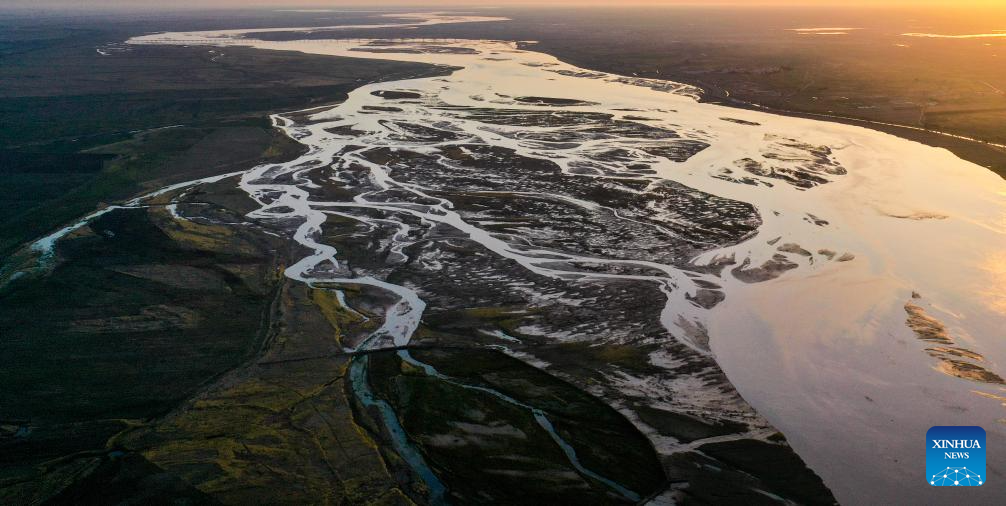
This aerial photo taken on Sept. 15, 2023 shows a view of the Yellow River in Shuanghe Town of Linhe District in Bayannur, north China's Inner Mongolia Autonomous Region.
The Hetao Irrigation Area, located in Bayannur, north China's Inner Mongolia Autonomous Region, has been diverting water from the Yellow River for irrigate since the Qin Dynasty (221 B.C.-206 B.C.). The current irrigation area stands at 11.54 million mu.
The 2,200-year-old irrigation project, included in the World Heritage Irrigation Structures in 2019, uses gravity to transport the Yellow River water into fields. As one of China's most important grain and oil production bases, this area has yielded over 3 billion kg of grain on average annually in recent years.
In recent years, Bayannur has explored the modernization, water-saving transformation and ecological governance of the Hetao Irrigation Area. It has used information technology to improve the fine management of this area and promote the efficient use of water resources in an environmentally friendly way. With these efforts, the Hetao Irrigation Area has seen a continuous sustainable development in recent years. (Xinhua/Lian Zhen)
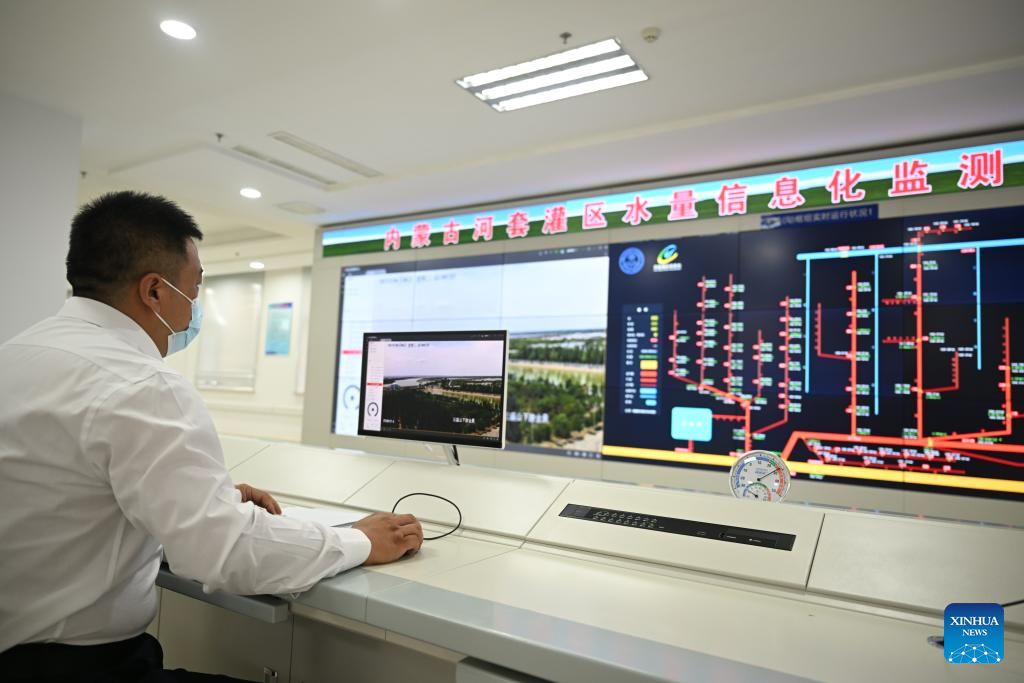
A staff member works at the water quantity monitoring center of the Hetao Irrigation Area in Bayannur, north China's Inner Mongolia Autonomous Region, June 6, 2023.
The Hetao Irrigation Area, located in Bayannur, north China's Inner Mongolia Autonomous Region, has been diverting water from the Yellow River for irrigate since the Qin Dynasty (221 B.C.-206 B.C.). The current irrigation area stands at 11.54 million mu.
The 2,200-year-old irrigation project, included in the World Heritage Irrigation Structures in 2019, uses gravity to transport the Yellow River water into fields. As one of China's most important grain and oil production bases, this area has yielded over 3 billion kg of grain on average annually in recent years.
In recent years, Bayannur has explored the modernization, water-saving transformation and ecological governance of the Hetao Irrigation Area. It has used information technology to improve the fine management of this area and promote the efficient use of water resources in an environmentally friendly way. With these efforts, the Hetao Irrigation Area has seen a continuous sustainable development in recent years. (Xinhua/Lian Zhen)
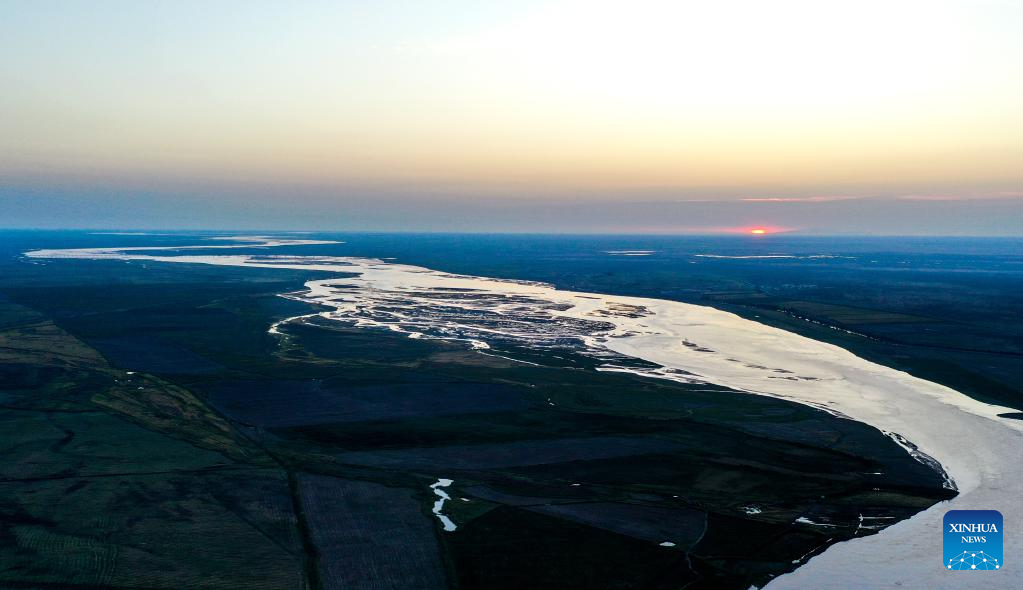
This aerial photo taken on Sept. 15, 2023 shows a view of the Yellow River in Shuanghe Town of Linhe District in Bayannur, north China's Inner Mongolia Autonomous Region.
The Hetao Irrigation Area, located in Bayannur, north China's Inner Mongolia Autonomous Region, has been diverting water from the Yellow River for irrigate since the Qin Dynasty (221 B.C.-206 B.C.). The current irrigation area stands at 11.54 million mu.
The 2,200-year-old irrigation project, included in the World Heritage Irrigation Structures in 2019, uses gravity to transport the Yellow River water into fields. As one of China's most important grain and oil production bases, this area has yielded over 3 billion kg of grain on average annually in recent years.
In recent years, Bayannur has explored the modernization, water-saving transformation and ecological governance of the Hetao Irrigation Area. It has used information technology to improve the fine management of this area and promote the efficient use of water resources in an environmentally friendly way. With these efforts, the Hetao Irrigation Area has seen a continuous sustainable development in recent years. (Xinhua/Lian Zhen)
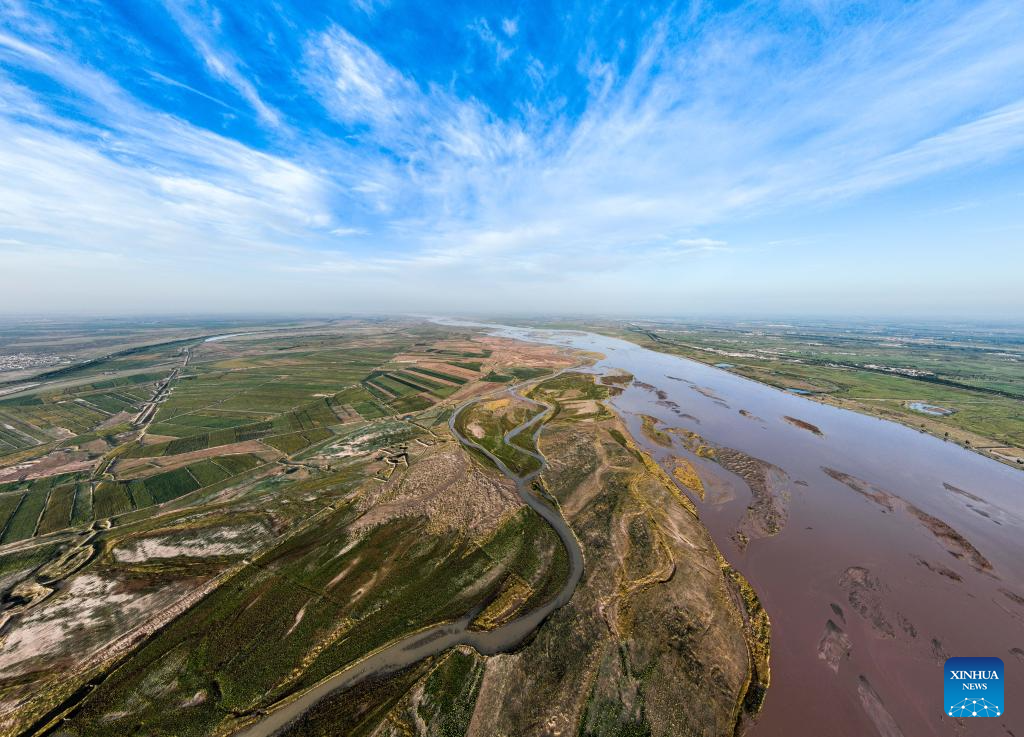
This aerial photo taken on Sept. 15, 2023 shows a view of the Yellow River in Shuanghe Town of Linhe District in Bayannur, north China's Inner Mongolia Autonomous Region.
The Hetao Irrigation Area, located in Bayannur, north China's Inner Mongolia Autonomous Region, has been diverting water from the Yellow River for irrigate since the Qin Dynasty (221 B.C.-206 B.C.). The current irrigation area stands at 11.54 million mu.
The 2,200-year-old irrigation project, included in the World Heritage Irrigation Structures in 2019, uses gravity to transport the Yellow River water into fields. As one of China's most important grain and oil production bases, this area has yielded over 3 billion kg of grain on average annually in recent years.
In recent years, Bayannur has explored the modernization, water-saving transformation and ecological governance of the Hetao Irrigation Area. It has used information technology to improve the fine management of this area and promote the efficient use of water resources in an environmentally friendly way. With these efforts, the Hetao Irrigation Area has seen a continuous sustainable development in recent years. (Xinhua/Xing Guangli)
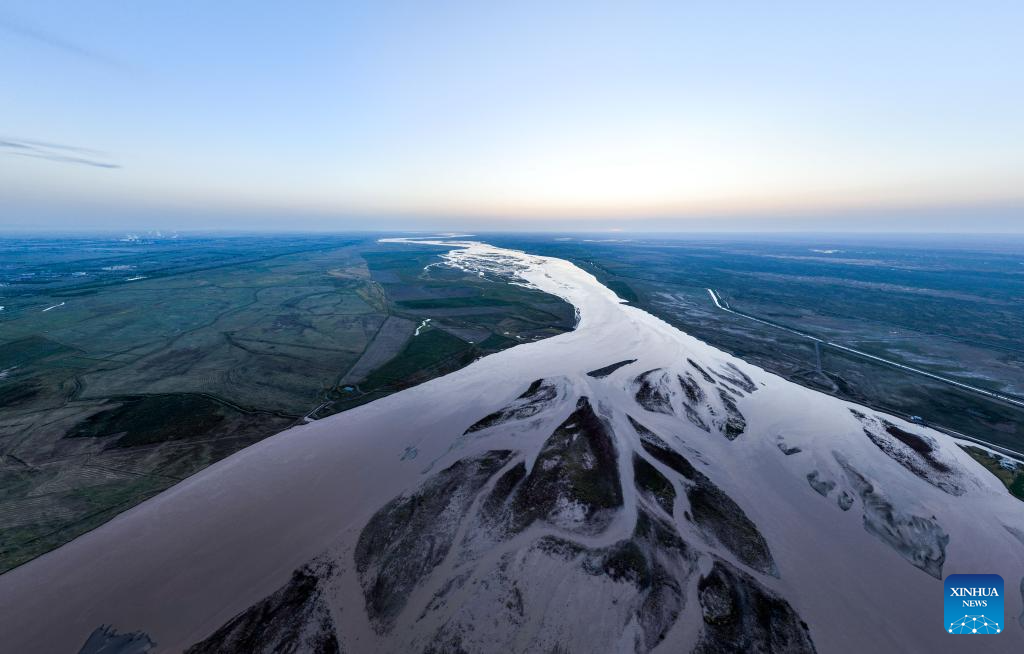
This aerial photo taken on Sept. 15, 2023 shows a view of the Yellow River in Shuanghe Town of Linhe District in Bayannur, north China's Inner Mongolia Autonomous Region.
The Hetao Irrigation Area, located in Bayannur, north China's Inner Mongolia Autonomous Region, has been diverting water from the Yellow River for irrigate since the Qin Dynasty (221 B.C.-206 B.C.). The current irrigation area stands at 11.54 million mu.
The 2,200-year-old irrigation project, included in the World Heritage Irrigation Structures in 2019, uses gravity to transport the Yellow River water into fields. As one of China's most important grain and oil production bases, this area has yielded over 3 billion kg of grain on average annually in recent years.
In recent years, Bayannur has explored the modernization, water-saving transformation and ecological governance of the Hetao Irrigation Area. It has used information technology to improve the fine management of this area and promote the efficient use of water resources in an environmentally friendly way. With these efforts, the Hetao Irrigation Area has seen a continuous sustainable development in recent years. (Xinhua/Xing Guangli)
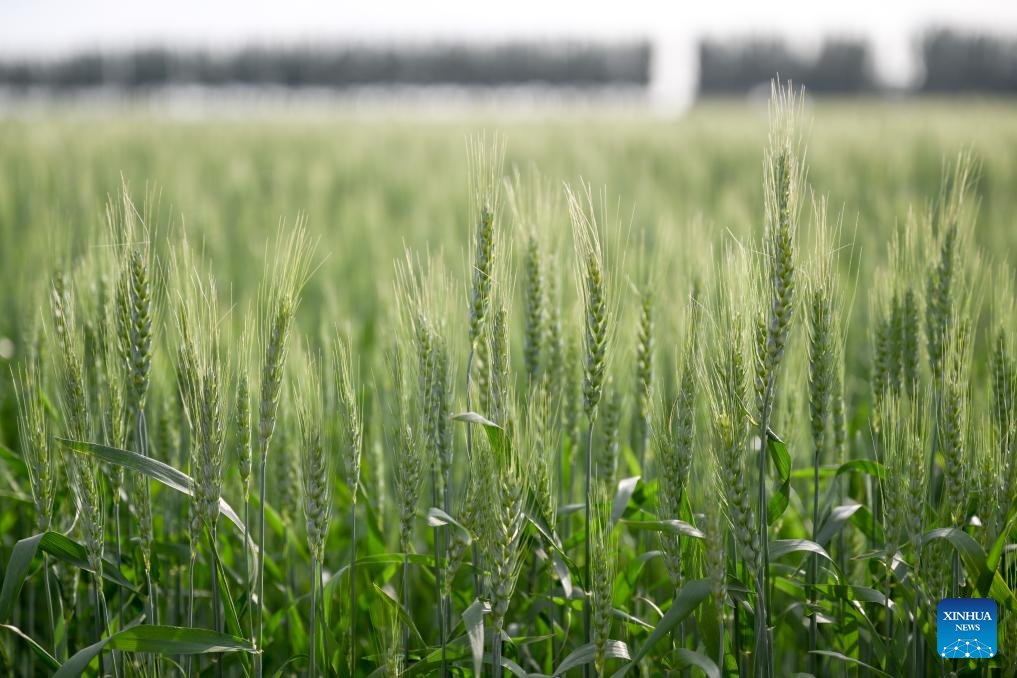
This photo taken on June 5, 2023 shows wheat crops in a modern agricultural demonstration field in Urad Front Banner in Bayannur, north China's Inner Mongolia Autonomous Region.
The Hetao Irrigation Area, located in Bayannur, north China's Inner Mongolia Autonomous Region, has been diverting water from the Yellow River for irrigate since the Qin Dynasty (221 B.C.-206 B.C.). The current irrigation area stands at 11.54 million mu.
The 2,200-year-old irrigation project, included in the World Heritage Irrigation Structures in 2019, uses gravity to transport the Yellow River water into fields. As one of China's most important grain and oil production bases, this area has yielded over 3 billion kg of grain on average annually in recent years.
In recent years, Bayannur has explored the modernization, water-saving transformation and ecological governance of the Hetao Irrigation Area. It has used information technology to improve the fine management of this area and promote the efficient use of water resources in an environmentally friendly way. With these efforts, the Hetao Irrigation Area has seen a continuous sustainable development in recent years. (Xinhua/Lian Zhen)
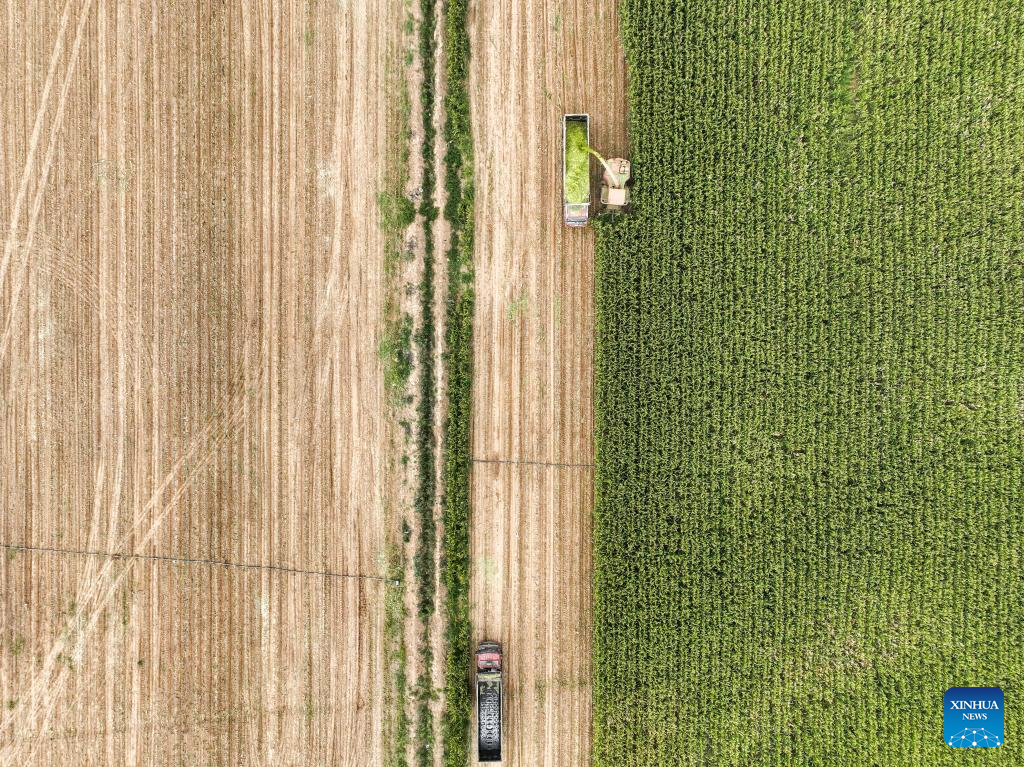
This aerial photo taken on Sept. 14, 2023 shows farmers operating harvesters to reap corn crops in Linhe District of Bayannur, north China's Inner Mongolia Autonomous Region.
The Hetao Irrigation Area, located in Bayannur, north China's Inner Mongolia Autonomous Region, has been diverting water from the Yellow River for irrigate since the Qin Dynasty (221 B.C.-206 B.C.). The current irrigation area stands at 11.54 million mu.
The 2,200-year-old irrigation project, included in the World Heritage Irrigation Structures in 2019, uses gravity to transport the Yellow River water into fields. As one of China's most important grain and oil production bases, this area has yielded over 3 billion kg of grain on average annually in recent years.
In recent years, Bayannur has explored the modernization, water-saving transformation and ecological governance of the Hetao Irrigation Area. It has used information technology to improve the fine management of this area and promote the efficient use of water resources in an environmentally friendly way. With these efforts, the Hetao Irrigation Area has seen a continuous sustainable development in recent years. (Xinhua/Xing Guangli)



